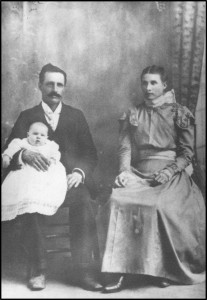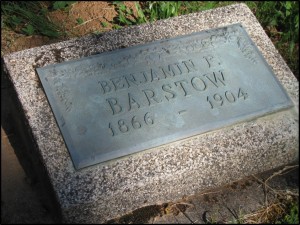
In 1866, Joseph and Nancy (Robbins) Barstow, named their fifth child Benjamin Franklin Butler Barstow, in honor of Benjamin Franklin Butler, controversial Union Army general and future governor of Massachusetts. Butler was a “political” general, appointed because of his political pull and had no military experience. Why did the couple name their child for him? Probably for two reasons. Joseph Barstow came from Massachusetts and the Robbins family, if not the Barstows, supported the pre-Civil War Democratic Party and Butler was one of it’s preeminent leaders in New England. In the future the child would be simply known as Ben (though he also appeared as “Butler” in several census records).
Ben Barstow was born when the family was living in the Stafford area, near the boundary between Clackamas and Washington counties, in Oregon. He was born three years after the death by drowning of his grandfather, Dr. Nathaniel Robbins. He had two older brothers, two older sisters, one of whom died in infancy, and two youngers sisters, again with only one living to adulthood. Sadly Ben also lost his mother when he was about six years of age, as Nancy died from the effects of giving birth to her last child in 1872. Ben’s father Joseph Barstow, who had come around the Horn to Oregon from New England, remained a widower until his death many years later in 1915.

Ben and Christina Barstow, with oldest daughter Iva, c1900
In 1899, Ben Barstow was married to Christina Groshong near the Clackamas county settlement of Wilhoit in the Cascades foothills. Wilhoit was the location of springs which brought visitors from near and farm. An article in the local Oregon City newspaper reported at the time: “A number of guests were present and a luxurious wedding dinner was served. The bride has resided at Wilhoit for a number of years and enjoys a host of friends.” Over the next several years Ben and Christina had three daughters, Iva, Harriet, and Marie, the last being born in November of 1904. They lived near Wilhoit and Scotts Mills a few miles to the south. Farming and logging were the primary occupations of the time.
But once again tragedy struck the Barstow family. Approximately two weeks after the birth of his last daughter, Ben Barstow was seriously injured in a logging accident.
The first newspaper mention of this incident comes from The Silverton Appeal on Friday, December 2, 1904: “Ben Barstow of Scotts Mills, was serious injured Monday, having met with the misfortune to dislocate his hip. He was also injured internally, and his condition is said to be critical. A local physician has the case in charge and reports the patient in favorable way to recovery at this writing.”
Unfortunately, that was not to be. The following Friday, the same newspaper reported: “Ben Barstow, who was injured at Scotts Mills Monday of last week, a brief mention of which was made in our last issue, died Saturday and was buried Monday.” Ben Barstow was 38 years old.
That would be all we knew of the incident except the Oregon City Enterprise carried a lengthy description of the incident under the headline “Met Horrible Death.” Both newspapers disagreed on which day of the week the incident happened (Monday or Tuesday) and which day of the week Barstow died (Saturday or Sunday).
The Enterprise reported,
The details of the accident and consequent suffering are harrowing in the extreme. It seems that last Tuesday he and another man were getting out raw logs and were hauling them over to a skidway leading to Coal creek. While hauling a big log over a rough piece of ground it made an unexpected turn and caught Mr. Barstow, who fell while the log rolled onto him, dragging for half its length across the hips and groins of the unfortunate man before the team could be stopped. Mr. Barstow was alone at the time and when his helper finally arrived he was unable to remove the heavy log and the only thing to do was to haul the log off with the team and this was done. The injured man could not stand to be carried, so he was dragged by the arm for about 300 yards, put on a sled and hauled home nearly a mile away. Medical aid was hastily summoned, and an examination proved that the bones in the hips were mashed and the lower part of the abdomen was crushed, causing serious internal injuries. He appeared to be improving at first, but he was gradually failing, and said himself that he had not long to live. Saturday night and Sunday morning he appeared quite cheerful and was telling stories and jokes to a circle of friends and relatives. Sunday morning he said: “Let my boy come in to rubber at me too.” He called his oldest daughter, a child of about four, his “boy.” When she came in he took her hands, pressed them to his face and fell back on the pillow dead.

His widow Christina later remarried to a man named John Sharp, not known to be any relation to her late husband’s uncle William Sharp. The girls grew up and married, though Iva, or “Boy” as her father called her, died in the influenza epidemic of the early 1920s. I was fortunate to correspond with and later meet the youngest daughter Marie who provided information about her family and the father she never knew.
(Jacob Robbins-William Robbins/Absalom Robbins-Nathaniel Robbins/Nancy Robbins-Nancy (Robbins) Barstow-Benjamin Franklin Butler Barstow)